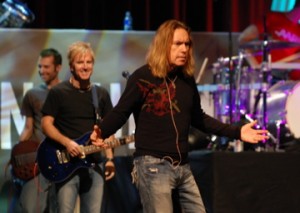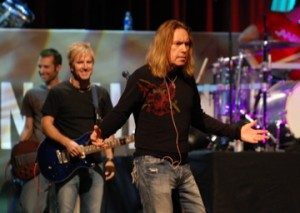


It was an important day – after 3 weeks of work with an artist on their live show, we were wrapping up a “moment” we were creating for their 55 date tour. I needed a little energy in a cup!
So I stopped at Starbucks just outside Nashville – one of the busiest in the southeast, I’m told. As I waited in line, I overheard a conversation between two guys in front of me about a new record release and upcoming tour.
I’d actually been approached by this guy’s record company and manager about working on his show, so I introduced myself. His reaction didn’t surprise me. He stepped back, looked at me suspiciously, and said, “Dude what are you talking about? Our show rocks!”
Obviously, he didn’t have the same opinion as his manager and record label.
I’m a Live Music Producer, and I’ve been working on artists’ shows for 20 years. I do what a record producer does for the recording – but I go into rehearsal halls and help artists get ready for their live shows, showcases, and tours.
Starbucks and the rehearsal hall are my world. I’ve been in the music business a long time, lived in Nashville 17 years, and the only reason I know where BMI, ASCAP, and a few recording studios are, is because they are on Nashville’s Music Row or a friend of mine owns one. But if you ask me where the best rehearsal studio is in Los Angeles, Toronto, New York, Austin, Orlando, or Timbuktu – I can tell you!
I also get asked to speak at music conferences and colleges around the world to teach my Live Music Method, which will help an artist get a vision for their show, help them be more comfortable and spontaneous onstage, and help them understand how to connect with an audience without changing who they are. It helps them get prepared to work with me and my team.
So I was asked by Kevin Breuner at CD Baby to write about the biggest mistakes artists make with their live show. Here are 5 big mistakes, in no particular order:
1. “Winging it” is mistaken for spontaneity
I constantly run across the attitude of “Dude, I’ve got to be spontaneous – I can’t rehearse my show!” Sometimes my reply is “Awesome – but if you really want to be spontaneous, make up the song right in front of the audience… that’d be real awesome!”
They look at me like I’m crazy or have 2 heads. Because of course they practice the music, dynamics, tempo, tones, melodies, and harmonies. They know those need to be right. And, if they’re a group, they work on making the music really tight. But instead of learning the right way to be spontaneous onstage, they mistake “winging it” for spontaneity! They jump around onstage and try different things, hoping something will work. And here’s the irony – when they do something verbally, visually, or musically in front of the crowd one night that gets a great response, they do that same thing the next night, too.
So where did the spontaneity go? They do the same thing they did the first night because it worked! That’s because spontaneity and winging it are 2 different things. In fact, if we rehearse right, we will leave room for spontaneity in our show.
Which brings me to the next mistake:
2. Practice is mistaken for rehearsal
Artists know when they go into the recording studio, they don’t lay down basic tracks, add a few sweeteners, and a scratch track vocally, then turn to the producer and say, “Sounds great. Let’s get it to the manufacturer!” An artist who has any sense at all knows there’s more to be done with the recording. You need a final mix. In fact, the mix can even make or break the song. It’s why people like Grammy winner Al Schmitt get paid a stupid amount just to mix people’s songs.
But most artists don’t realize there is more to getting a live show ready than just “practicing” the music. Rehearsal involves the musical, the visual, the verbal, the rearranging of songs that were written for radio so they work live, and more.
Which brings us to mistake #3:
3. Song arrangements intended for radio are mistakenly used for live shows
Some of you have heard me talk about the qualities of a sitcom for TV (22 min. of show + 8 min. of commercials = sitcom). As a musician, our equivalent to a sitcom is a song for radio. We know the rules for getting played on radio: 3-4 minutes long, a certain form, short intro, etc. But a live show and radio are 2 different things!
The Simpsons sitcom was made into a movie a few years ago. As a consumer, if you’d gone to the theater and paid $10 for 22 minutes of show plus 8 minutes of commercials, you’d have felt cheated. Why? Your expectations are different in a theater. Well, your audience’s expectations are different at a club or concert hall than they are when they turn on a radio. If you play your songs just as they were recorded for radio, you’re making a big mistake. Those songs need to be rearranged to create a compelling live show.
Not understanding the audience’s expectations is part of the 4th mistake:
4. Artists assume the audience wants them to sing songs or play music
Audiences go to a live concert for 3 reasons: to be captured & engaged, to experience moments, and to have their lives changed in some way. As musicians, we make the mistake of thinking (partly because it’s us, our adrenaline is flowing, and we’re playing our own music) that we are awesome onstage and there are “moments” all through our songs. And there are – for us. But we need to create moments for our audience!
That’s what a huge part of rehearsal is: finding the moments in the songs, and rearranging them so they become moments for the audience (not just us). Living in Nashville, a huge part of the music industry is still consumed with having a “hit song.” A hit song will compel people (usually listening on radio) to go to iTunes or Google the artist to find the song… because it moved them emotionally. In other words, a hit song is a “moment” that connects the listener emotionally to the artist. It’s a distinct craft and art. And it’s why the best producers in the world get paid extraordinary sums to produce those hits for the artist!
But even well written songs don’t necessarily become hits. (If that were the case, the tens of 1000s of songs written every year around the world that are well crafted, lyrically clever, and well arranged would all be hits.) But here’s the good news: if you have a well written song, inside that song is usually a “moment!” You as the artist know it! And the Live Music Producer’s job is to find that moment and help you deliver it in your live show. But if you’re just playing songs, most people will miss those moments.
That’s why delivering a song live onstage is so important, and you shouldn’t make mistake #5:
5. Artists’ songs all look the same, even though they don’t sound the same
As an artist you know your songs are all different. They have different themes, melodies, rhythms, and tones. They don’t sound the same. But (for 95% of artists out there) they look the same. You need to be as creative with your show as you are with your music. Communication with your audience is 15% content, 30% tone or emotion, and 55% is what they see. So it can be a real problem if your songs all look the same, because to an audience that doesn’t know who you are, your songs will start sounding the same. Most artists typically do the same thing onstage over and over for every song: the same movement from the same place… big mistake!
Oh, by the way, I never did work with the guy in Starbucks. A couple years later I walked into the same Starbucks, and saw him again – this time he was working the counter. A part of me wanted to gloat. But in reality, I felt sorry for him, because I thought he had written some good songs and he had a good band. They were just boring onstage. And it was too bad he didn’t know it.
———————————
TOM JACKSON BIO:
A Live Music Producer and master of creating moments onstage, Tom has taught 100s of artists of every genre – major artists like Taylor Swift, The Band Perry, Jars of Clay, & others – and countless indies, giving them a foundation and direction to define their unique voice and style to showcase their talent from the stage. A highly demanded speaker, Tom shares his knowledge at music colleges, conferences & events worldwide, impacting tens of thousands of artists every year. For more information and resources for your live show, go to www.OnstageSuccess.com.
[hana-code-insert name=’touring-book-your-own’ /]